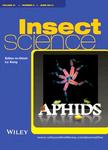Potential adaptation of a Q biotype whitefly population from poinsettia to field crops
Potential adaptation of a Q biotype whitefly population from poinsettia to field crops作者机构:College of Plant Protection NorthwestA & F University Yangfing Shaanxi Province China Department of Entomology and BI05 Institute University of Arizona Tucson Arizona USDA-ARS Crop Genetics and Breeding Research Unit Tifton Georgia Cotton Incorporated Cary North Carolina USA
出 版 物:《Insect Science》 (昆虫科学(英文版))
年 卷 期:2011年第18卷第6期
页 面:719-728页
核心收录:
学科分类:0710[理学-生物学] 0830[工学-环境科学与工程(可授工学、理学、农学学位)] 090706[农学-园林植物与观赏园艺] 0907[农学-林学] 09[农学] 090101[农学-作物栽培学与耕作学] 0904[农学-植物保护] 0901[农学-作物学] 0713[理学-生态学]
基 金:This research was supported by USDA PMAP grant Cotton Incorporated cooperative research agreement Arizona Cotton Growers Association grant
主 题:Bemisia tabaci host adaptation life history traits population establishment,Q-biotype.
摘 要:The invasive Q biotype whitefly was first detected in the US on poinsettia in 2004 and is still not a pest outside of greenhouse environments in the US. To assess the potential for the establishment of the Q biotype on field crops, population cage experiments were conducted to compare the performance of a poinsettia-derived Q population named P'06 on poinsettia and six field crops (alfalfa, tomato, melon, cotton, cowpea and cabbage). P'06 adults reared on poinsettia as nymphs laid eggs on all six field crops. Significantly more eggs were laid on alfalfa, tomato, melon and cotton than on cabbage, cowpea and poinsettia. These eggs hatched and the nymphs developed to adults on the six field crops. Relative to poinsettia, whitefly survival was similar on cowpea, alfalfa, tomato and cabbage, but significantly higher on cotton and melon. Moreover, P'06 had significantly shorter development times from egg to adult on cotton, melon, cowpea, tomato and alfalfa than they did on poinsettia. However, the F1 adults raised on the six field crops had significantly shorter lifespans and laid 11- to 18-fold fewer eggs than did the F1 adults raised on poinsettia. Taken together, while P'06 may have some potential to establish on field crops, the shorter lifespans and extremely low fectmdities of the F1 adults raised on the six field crops suggests that P'06 is incapable of rapidly adapting to them. Poor adaptation to field crops may explain, at least partially, why the Q biotype has not established in the US field system.



